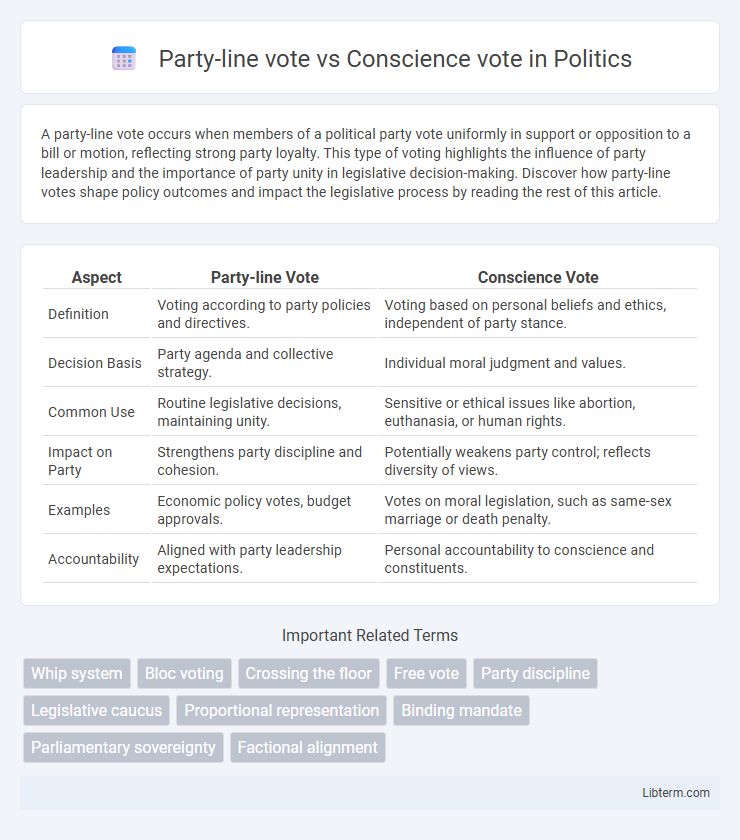A party-line vote occurs when members of a political party vote uniformly in support or opposition to a bill or motion, reflecting strong party loyalty. This type of voting highlights the influence of party leadership and the importance of party unity in legislative decision-making. Discover how party-line votes shape policy outcomes and impact the legislative process by reading the rest of this article.
Table of Comparison
| Aspect | Party-line Vote | Conscience Vote |
|---|---|---|
| Definition | Voting according to party policies and directives. | Voting based on personal beliefs and ethics, independent of party stance. |
| Decision Basis | Party agenda and collective strategy. | Individual moral judgment and values. |
| Common Use | Routine legislative decisions, maintaining unity. | Sensitive or ethical issues like abortion, euthanasia, or human rights. |
| Impact on Party | Strengthens party discipline and cohesion. | Potentially weakens party control; reflects diversity of views. |
| Examples | Economic policy votes, budget approvals. | Votes on moral legislation, such as same-sex marriage or death penalty. |
| Accountability | Aligned with party leadership expectations. | Personal accountability to conscience and constituents. |
Understanding Party-line Voting
Party-line voting occurs when legislators cast their votes strictly according to their political party's policies or directives, often to maintain party unity and discipline. This practice influences legislative outcomes by consolidating support for party agendas, resulting in predictable voting patterns aligned with party ideologies. Understanding party-line voting is essential for analyzing legislative behavior and predicting the passage of bills within partisan contexts.
What is a Conscience Vote?
A conscience vote, also known as a free vote, allows legislators to vote according to their personal beliefs rather than following official party policy. Unlike a party-line vote, where members are expected to align with party decisions to maintain unity, a conscience vote grants individual autonomy on morally or ethically sensitive issues. This practice is common in parliamentary systems when topics like euthanasia, abortion, or same-sex marriage arise.
Key Differences Between Party-line and Conscience Votes
Party-line votes require members of a political party to vote uniformly according to the party's stance, ensuring party cohesion and legislative predictability. Conscience votes allow legislators to vote based on personal beliefs or moral considerations, often on ethically divisive or socially sensitive issues. This distinction highlights the tension between party discipline and individual autonomy within legislative decision-making.
Historical Examples of Party-line Votes
Party-line votes have historically shaped major legislative outcomes, such as the Civil Rights Act of 1964 where most Democrats and Republicans voted along party lines, highlighting sharply divided stances on civil rights. The Affordable Care Act passage in 2010 also exemplifies party-line voting, with Democrats largely supporting and Republicans opposing the legislation, reflecting ideological divisions on healthcare reform. These examples underscore the influential role of party loyalty in legislative decision-making and the political dynamics within the U.S. Congress.
Notable Cases of Conscience Voting
Notable cases of conscience voting often involve pivotal moments in legislative history where lawmakers prioritize personal beliefs over party lines, exemplified by the 1964 U.S. Civil Rights Act vote where several Democrats broke ranks to support the bill against Southern opposition. In the 2016 Australian same-sex marriage postal survey, numerous MPs voted according to conscience rather than party policy, reflecting societal shifts and personal convictions. The UK's 2019 Brexit votes saw significant conscience voting as members defied party directives to express individual stances on national sovereignty and economic strategy.
Impact on Legislative Decision-Making
Party-line votes streamline legislative decision-making by ensuring cohesive policy implementation aligned with party agendas, enhancing predictability and unity within the legislative body. Conscience votes empower individual legislators to vote based on personal beliefs or constituency interests, which can foster diverse viewpoints but may introduce unpredictability and reduce party control over legislative outcomes. The balance between these voting methods significantly influences the dynamics of governance, legislative efficiency, and policy responsiveness.
Party Discipline vs. Individual Responsibility
Party-line votes emphasize strict party discipline, requiring members to align their votes with the party's official stance to maintain unity and collective strategy. Conscience votes prioritize individual responsibility, allowing legislators to vote based on personal beliefs or the interests of their constituents rather than party directives. This distinction highlights the tension between maintaining political cohesion and respecting individual moral judgment within legislative decision-making.
Public Perception of Voting Methods
Party-line voting is often perceived by the public as a demonstration of political unity and discipline, reflecting alignment with party policies and leadership. In contrast, conscience voting is viewed as an act of individual integrity, where legislators prioritize personal ethics or constituency interests over party directives. Public perception tends to favor conscience votes as a sign of authentic representation, while party-line votes may be criticized for promoting partisanship and limiting independent judgment.
Advantages and Disadvantages of Each Approach
Party-line voting ensures legislative unity and streamlined decision-making, promoting clear party platforms but may suppress individual representative judgment and constituent interests. Conscience voting allows legislators to independently assess issues, fostering diverse perspectives and moral integrity while risking party fragmentation and reduced policy coherence. Balancing these approaches is crucial for democratic responsiveness and effective governance.
The Future of Voting Practices in Modern Legislatures
Party-line voting remains a dominant practice in modern legislatures, ensuring cohesive policy agendas but often limiting individual lawmaker autonomy. Conscience voting, which allows legislators to vote based on personal or ethical beliefs, is gaining traction as a means to foster more nuanced and representative democracy. The future of voting practices may see a hybrid approach, balancing party unity with increased opportunities for conscience votes to enhance legislative deliberation and public trust.
Party-line vote Infographic

 libterm.com
libterm.com